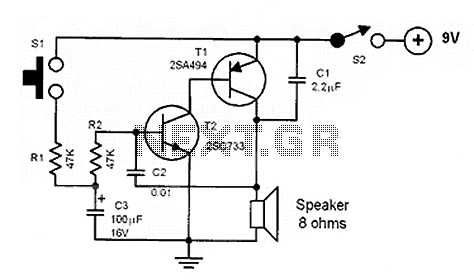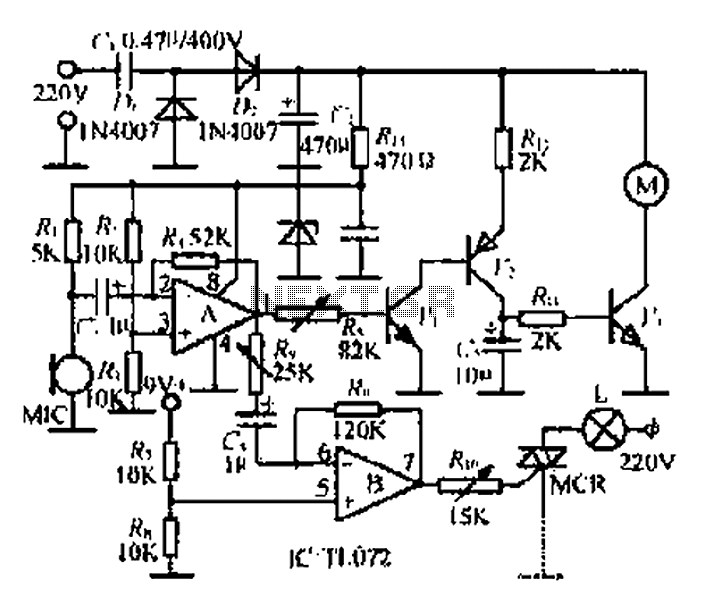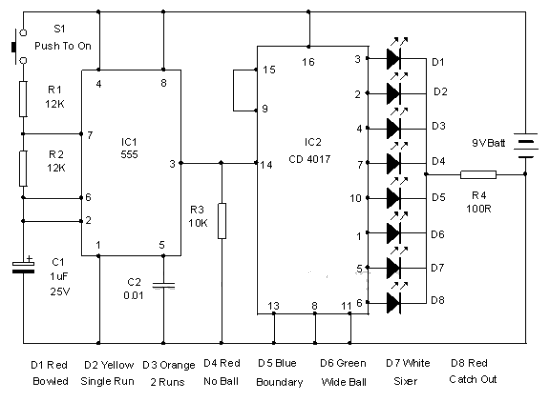
Electronic Siren

The sound produced imitates the rise and fall of an American police siren. When first switched on, the 10µF capacitor is discharged, and both transistors are off. When the push button switch is pressed, the 10µF capacitor will charge via the 22kΩ resistor. This voltage is applied to the base of the BC108B transistor, which will turn on slowly. When the switch is released, the capacitor will discharge through the 100kΩ and 47kΩ base resistors, causing the transistor to slowly turn off. The change in voltage alters the frequency of the siren. The oscillator action is more complex. As the BC108B transistor switches on, its collector voltage falls, which in turn switches on the 2N3702 transistor very quickly (in less than 1µs). The 22nF capacitor will also charge rapidly. Since this capacitor is connected between the collector of the 2N3702 and the base of the BC108B, it quickly approaches nearly full supply voltage. The charging current for the capacitor is then significantly reduced, resulting in an increased collector-emitter voltage of the 2N3702, causing the collector potential to fall. This change in voltage is transmitted through the 22nF capacitor to the base of the BC108B, causing it to slightly exit saturation. As this occurs, its collector voltage rises, further turning off the 2N3702 transistor. This cycle continues until both transistors are off. The 22nF capacitor then discharges through the 100kΩ and 22kΩ resistors, the closed push button switch, the 9V battery, the speaker, and the 56Ω resistor. The discharge time takes approximately 5-6 milliseconds. Once the 22nF capacitor is discharged, the BC108B transistor will switch on again, and the cycle repeats. The difference in voltage at the collector of the BC108B, caused by the charging 10µF capacitor, results in a change in the siren's tone. As the 10µF capacitor charges, the tone of the siren rises, and as it discharges, the tone falls. A 64Ω loudspeaker may be used in place of the 8Ω speaker and 56Ω resistor, and the component values may be modified to create different sound effects.
The circuit described functions as an audio oscillator, emulating the characteristic sound of a police siren through a series of transistors and capacitors. The BC108B and 2N3702 transistors serve as the primary switching elements, with the BC108B acting as the main control transistor and the 2N3702 as a secondary amplifier that responds to changes in the collector voltage of the BC108B.
When the push button switch is engaged, the 10µF capacitor begins to charge, leading to a gradual increase in voltage at the base of the BC108B. This slow turn-on characteristic creates a ramp-up effect in the sound output, simulating the rising pitch of a siren. Once the button is released, the discharge path for the 10µF capacitor through the resistors allows for a gradual decrease in voltage, resulting in a falling pitch of the sound.
The 22nF capacitor plays a crucial role in the rapid switching of the 2N3702 transistor. Its quick charge and discharge characteristics facilitate a feedback loop that enhances the oscillation frequency of the circuit. The interaction between the charging and discharging of the capacitors and the switching of the transistors creates a modulated sound wave that mimics the siren's rise and fall.
The choice of resistors, specifically the 22kΩ and 100kΩ, along with the capacitors, determines the timing characteristics of the oscillation. Adjusting these values can lead to variations in the frequency and tone of the siren sound. The inclusion of different speaker impedances, such as a 64Ω loudspeaker, allows for flexibility in sound output and volume levels.
Overall, this circuit exemplifies a simple yet effective method for generating audio signals that can be tailored for various applications, including alarms and sound effects in electronic projects.The sound produced imitates the rise and fall of an American police siren. When first switched on the 10u capacitors is discharged and both transistors are off. When the push button switch is pressed to 10u capacitor will charge via the 22k resistor. This voltage is applied to the base of the BC108B which will turn on slowly. When the switch is re leased the capacitor will discharge via the 100k and 47k base resistors and the transistor will slowly turn off. The change in voltage alters the frequency of the siren. The oscillator action is more difficult to work out. As the BC108B transistor switches on its collector voltage falls and so the 2N3702 transistor is switched on.
This happens very quickly ( less than 1us). The 22n capacitor will charge very quickly as well. As this capacitor is connected between the collector of the 2N3702 and the base of the BC108B, it soon reaches almost full supply voltage. The charging current for the capacitor is then much reduced and the collector emitter voltage of the 2N3072 is therefore increased; the collector potential will fall.
This change in voltage is passed through the 22n capacitor to the base of the BC108B causing it to come out of saturation slightly. As this happens its collector voltage will rise and turn off the 2N3072 transistor more. This continues until both transistors are off. The 22n capacitor will then discharge via the 100k, 22k resistor, the closed push button switch, 9V battery, the speaker and 56 ohm resistor.
The discharge time takes around 5-6msec. As soon as the 22n capacitor is discharged, the BC108B transistor will switch on again and the cycle repeats. The difference in voltage at the collector of the BC108B (caused by the charging 10u capacitor) causes the tone of the siren to change.
As the 10u capacitor is charged, the tone of the siren will rise, and as it is discharged, it will fall. A 64 ohm loudspeaker may be used in place of the 8 ohm and 56 resistor, and the values of components may be altered to produce different sound effects.
🔗 External reference
The circuit described functions as an audio oscillator, emulating the characteristic sound of a police siren through a series of transistors and capacitors. The BC108B and 2N3702 transistors serve as the primary switching elements, with the BC108B acting as the main control transistor and the 2N3702 as a secondary amplifier that responds to changes in the collector voltage of the BC108B.
When the push button switch is engaged, the 10µF capacitor begins to charge, leading to a gradual increase in voltage at the base of the BC108B. This slow turn-on characteristic creates a ramp-up effect in the sound output, simulating the rising pitch of a siren. Once the button is released, the discharge path for the 10µF capacitor through the resistors allows for a gradual decrease in voltage, resulting in a falling pitch of the sound.
The 22nF capacitor plays a crucial role in the rapid switching of the 2N3702 transistor. Its quick charge and discharge characteristics facilitate a feedback loop that enhances the oscillation frequency of the circuit. The interaction between the charging and discharging of the capacitors and the switching of the transistors creates a modulated sound wave that mimics the siren's rise and fall.
The choice of resistors, specifically the 22kΩ and 100kΩ, along with the capacitors, determines the timing characteristics of the oscillation. Adjusting these values can lead to variations in the frequency and tone of the siren sound. The inclusion of different speaker impedances, such as a 64Ω loudspeaker, allows for flexibility in sound output and volume levels.
Overall, this circuit exemplifies a simple yet effective method for generating audio signals that can be tailored for various applications, including alarms and sound effects in electronic projects.The sound produced imitates the rise and fall of an American police siren. When first switched on the 10u capacitors is discharged and both transistors are off. When the push button switch is pressed to 10u capacitor will charge via the 22k resistor. This voltage is applied to the base of the BC108B which will turn on slowly. When the switch is re leased the capacitor will discharge via the 100k and 47k base resistors and the transistor will slowly turn off. The change in voltage alters the frequency of the siren. The oscillator action is more difficult to work out. As the BC108B transistor switches on its collector voltage falls and so the 2N3702 transistor is switched on.
This happens very quickly ( less than 1us). The 22n capacitor will charge very quickly as well. As this capacitor is connected between the collector of the 2N3702 and the base of the BC108B, it soon reaches almost full supply voltage. The charging current for the capacitor is then much reduced and the collector emitter voltage of the 2N3072 is therefore increased; the collector potential will fall.
This change in voltage is passed through the 22n capacitor to the base of the BC108B causing it to come out of saturation slightly. As this happens its collector voltage will rise and turn off the 2N3072 transistor more. This continues until both transistors are off. The 22n capacitor will then discharge via the 100k, 22k resistor, the closed push button switch, 9V battery, the speaker and 56 ohm resistor.
The discharge time takes around 5-6msec. As soon as the 22n capacitor is discharged, the BC108B transistor will switch on again and the cycle repeats. The difference in voltage at the collector of the BC108B (caused by the charging 10u capacitor) causes the tone of the siren to change.
As the 10u capacitor is charged, the tone of the siren will rise, and as it is discharged, it will fall. A 64 ohm loudspeaker may be used in place of the 8 ohm and 56 resistor, and the values of components may be altered to produce different sound effects.
🔗 External reference





